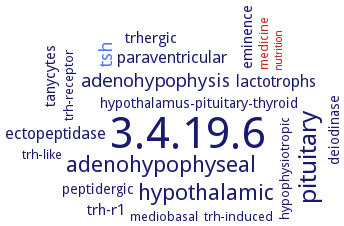3.4.19.6: pyroglutamyl-peptidase II
This is an abbreviated version!
For detailed information about pyroglutamyl-peptidase II, go to the full flat file.

Word Map on EC 3.4.19.6 
-
3.4.19.6
-
pituitary
-
adenohypophyseal
-
hypothalamic
-
adenohypophysis
-
tsh
-
paraventricular
-
ectopeptidase
-
lactotrophs
-
trh-r1
-
trhergic
-
eminence
-
tanycytes
-
deiodinase
-
hypothalamus-pituitary-thyroid
-
peptidergic
-
trh-receptor
-
mediobasal
-
hypophysiotropic
-
trh-induced
-
medicine
-
trh-like
-
nutrition
- 3.4.19.6
- pituitary
- adenohypophyseal
- hypothalamic
- adenohypophysis
- tsh
-
paraventricular
-
ectopeptidase
-
lactotrophs
-
trh-r1
-
trhergic
-
eminence
- tanycytes
-
deiodinase
-
hypothalamus-pituitary-thyroid
-
peptidergic
-
trh-receptor
-
mediobasal
-
hypophysiotropic
-
trh-induced
- medicine
-
trh-like
- nutrition
Reaction
release of the N-terminal pyroglutamyl group from pGlu-/-His-Xaa tripeptides and pGlu-/-His-Xaa-Gly tetrapeptides =
Synonyms
aminopeptidase, thyrotropin-releasing factor pyroglutamate, PAP type II, PPII, pyroglutamate aminopeptidase II, pyroglutamyl aminopeptidase II, pyroglutamyl peptidase II, pyrrolidone carboxypeptidase type II, thyroliberin-hydrolyzing pyroglutamate aminopeptidase, thyroliberinase, thyrotropin-releasing hormone-degrading peptidase, thyrotropin-releasing hormone-degrading pyroglutamate aminopeptidase, TRH aminopeptidase, TRH-DE, TRH-degrading ectoenzyme, TRH-degrading enzyme, TRH-specific aminopeptidase
ECTree
Advanced search results
Natural Substrates Products
Natural Substrates Products on EC 3.4.19.6 - pyroglutamyl-peptidase II
Please wait a moment until all data is loaded. This message will disappear when all data is loaded.
REACTION DIAGRAM
additional information
?
-
-
detection of a RNA species derived from an alternative processing at the exon 14intron 14 boundary. The alternatively processed RNA encodes a shorter version of PPII (PPII*), lacking part of the C-terminal domain. PPII* is expressed in COS-7 (or C6 glioma) cells but it does not exhibit any PPII activity. Co-transfection of PPII and increasing amounts of PPII* expression vectors results in a dose-dependent reduction in PPII activity and the formation of covalent PPIIPPII* heterodimers. PPII* is therefore a powerful dominant-negative isoform of PPII, and heterodimerization may be its mechanism of action. Natural expression of shortened versions of M1 aminopeptidases may constitute a new mode of regulation of their activity
-
-
?
thyroliberin + H2O
?
-
may control the biological activity of the neuronally released thyrotropin
-
-
?
thyroliberin + H2O
?
-
involved in the conversion of thyrotropin-releasing hormone into histidyl-proline diketopiperazine
-
-
?


 results (
results ( results (
results ( top
top






